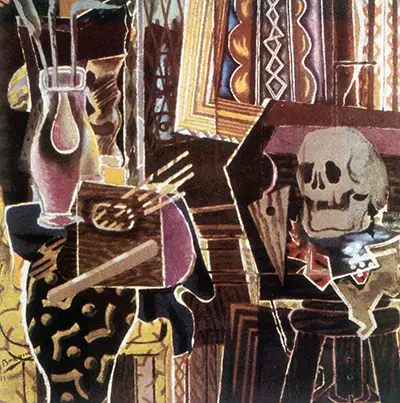What we see in front of us here is a sub-genre of still life art known as Vanitas, translating from latin as Vanity. Its purpose is to remind us of our own mortality, which is often achieved through the inclusion of a skull, as found here. It is also intended to warn against materialism too. Vanitas was popular with Dutch art in previous centuries, but its inclusion within Cubism was more of a surprise. Artist Braque produced several different paintings of the same name as this one, all in 1938. Within this iteration, the skull can be seen out on the right hand side, but we are immediately overcome by the amount of detail which is found across the artwork, leaving us unsure where to initially focus our eyes.
The other versions were of similar content, just with the elements re-arranged. One of the alternative pieces sold at Christie's for $449,500 in 2002. Within the painting found in this page, we find also a tall vase with flowers, various items of furniture, including a table with carefully crafted wood effect and also a frame in the background. There are a multitude of patterned elements at the back too, which actually take your attention fairly early on, such is the busy nature of their design, and also the way in which they clash against each other. The main background colour is a dark brown but we find a brighter colour scheme here than is found in many other cubist paintings, with tones of purple, yellow and red used in various parts of the scene.
There is an inner turmoil depicted within this series of work. The objects essentially represent his own misery, caused by war, specifically the return from WWI and the impending start of WWII. In fact, the colour scheme is deliberately bright and bold in order to better convey his own disatisfaction with elements of society at this time. It is unfortunate to discover what lies behind this impressive series of work, but certainly helps us to better understand just what exactly has gone on.


